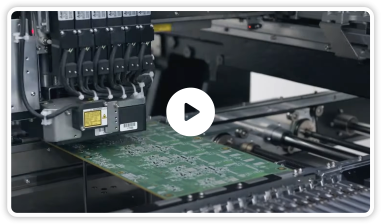Unless prevented, the outermost copper layers of a PCB or printed circuit board will oxidize as they come into contact with air, and this will reduce the soldering ability of the copper surfaces. PCB manufacturers use various surface finishes to prevent this from happening. The surface finish acts as protection, preventing the copper surface from oxidizing, thereby maintaining its soldering and electrical performance.
At Rush PCB Inc., we use several surface finishes, each offering different results appropriate for specific applications. One of them is the ENEPIG or Electroless Nickel Electroless Palladium Immersion Gold surface finish. Not only does this finish offer abundant benefits, but it also makes the board suitable for a variety of applications.

What is ENEPIG?
ENEPIG, a type of metal plating for PCBs, was developed a few decades ago and has recently gained popularity on account of its relatively low cost compared to other types of plating methods. With the prices of palladium decreasing substantially over the past many years, manufacturers are using it as a substitute for pure gold. As this reduces plating costs further, the ENEPIG process has gained even more popularity in electronic plating situations.
The ability to be deposited on just about any type of PCB surface has earned ENEPIG the nickname of the Universal Surface Finish. ENEPIG finishes primarily support soldering, aluminum, and gold bonding wires. Additionally, ENEPIG plating is also helpful in extending the functional shelf life of a PCB well beyond a year.
How Effective is ENEPIG?
An ENEPIG surface finish involves four layers of metal deposition on the PCB surface—copper, nickel, palladium, and gold. The following steps are necessary for creating an ENEPIG surface finish:
Copper Activation
This step selectively activates the copper layer that needs protection. This determines the deposition pattern in the next step, the electroless nickel plating. A displacement reaction, making the copper layer act as a catalytic surface, completes the process.
Electroless Nickel Plating
An oxidation-reduction reaction deposits a layer of nickel on the catalytic copper surface. Here, nickel typically acts as a barrier layer, preventing copper from interacting with the other metals that will be deposited subsequently. This layer is about 3 – 5 microns thick.
Electroless Palladium Plating
The palladium acts as another barrier layer, preventing the nickel layer from diffusing into and corroding the final gold layer. This layer also acts as an anti-oxidation and anti-corrosion layer. An electroless reaction deposits the palladium layer just like it does for the nickel layer. This chemical oxidation-reduction reaction causes the nickel surface to react with the palladium and form a thin layer. Depending on the application, the palladium deposition is a layer typically with a thickness of 0.05 – 0.1 microns.
Immersion Gold Plating
This is the final layer on the PCB, with the gold providing low contact resistance, resistance to oxidation, and protection from friction. The gold layer also helps to preserve the solderability of palladium. The immersion gold plating, as its name suggests, completely immerses the plated surface, as the palladium on the nickel dissolves, releasing electrons to reduce the gold atoms that surround it. The released gold ions, in turn, attach to the PCB surface, replacing some palladium ions. This results in a thin gold outer layer with a thickness of about 0.03 – 0.05 microns. This is substantially lower than that of any other gold plating technique.
Benefits of ENEPIG
The popularity of ENEPIG is due to its profound benefits, such as:
Cost-Effective
Although the ENEPIG process involves several processing steps that increase its cost, the overall cost is much lower than any other electrolytic nickel/electrolytic gold plating such as ENEG. The reason is that the use of palladium in the ENEPIG process reduces the material cost and the thickness of the gold plating, further reducing the cost.
Highly Durable
The multiple layers of the ENEPIG process provide a highly corrosion-resistant finish, mainly due to the anti-corrosive nature of the gold and palladium layers. The corrosion-resistant finish actively prevents nickel from turning black, a sign of nickel corrosion. Moreover, the outer surface of the finish is pore-free and smooth, providing fewer chances of trapping corrosive elements that may corrode it.
Excellent Solderability
The ENEPIG surface finish offers excellent strength for solder joints. The plating type is compatible with different alloys that lead-free solders typically use. Additionally, it can withstand multiple reflow soldering cycles without degrading. This compatibility is due to the palladium in the finish completely dissolving during the soldering process. It produces an oxide-free nickel surface suitable for a stable nickel-to-tin soldering connection.
High Wire Bond Pull Strength
ENEPIG plating offers good support for both aluminum and gold wires, with the plating providing exceptional bondability and protection to the wires even under long periods of stress.
Lower Contact Resistance
Resistance in PCBs is associated with heating, poor grounding, and energy losses. Lowering the contact resistance with the ENEPIG surface finish helps substantially reduce all of them. The lower contact resistance is due to the controlled and uniform deposition of the nickel, palladium, and gold layers.
Protective Barriers
In an ENEPIG finish, both the nickel and palladium layers act as protective barriers, preventing the tin in the solder from affecting the copper on the board. Apart from preventing the copper from mixing with gold and impacting conductivity, these barriers substantially improve solderability.
Use with Conductive Adhesives
Rather than using solder for attaching components to a PCB, some processes require using conductive adhesives instead. ENEPIG offers good support for such adhesives.
Limitless Shelf Life
There are several surface finish options for PCBs using aluminum, copper, and silver, but they are subject to oxidation and tarnishing. On the other hand, palladium and gold layers in the ENEPIG finish do not oxidize or tarnish. Exposure of the PCB to air and humidity leads to a progressive decline in its solderability and quality, which worsens over time. However, the ENEPIG surface finish, with its protective layers of palladium and gold, allows the PCB to remain in its original condition even after long storage periods.
Learn More About ENEPIG Surface Finish
Talk to Rush PCB Inc. today to learn if the ENEPIG surface finish is the right solution for your application. We provide a comprehensive, desirable, and durable solution for your PCB needs with our experienced plating crew.
With an extensive experience in plating services, including ENEPIG, we offer you the expertise to help you select the best method for your application, including the know-how to get it done.
Whether you need immersion gold plating, palladium plating, or ENEPIG plating, we can help you achieve the best results by developing a suitable process to meet not only your business needs but also keep your costs low.
FAQs
Why do PCBs Require ENEPIG Surface Finish?
What Benefits Does ENEPIG Offer?
How is ENEPIG Different from ENIG and ENEG?
ENIG is electroless nickel immersion gold plating very close to ENEPIG. However, the absence of the palladium layer between the nickel and gold layers reduces its reliability, allowing tin and gold to interact producing problematic intermetallics. This also fails to prevent nickel corrosion.ENEG is electroless nickel electroless gold plating providing better gold wire bonding as compared to ENIG. However, the gold layer in ENEG is substantially thicker making it more expensive than others. The thick gold layer also reduces the reliability of solder joints.
ENEPIG has a palladium layer that prevents nickel from corroding and also reacting with the gold layer. This improves the reliability substantially. Moreover, the gold layer in ENEPIG is substantially thinner, resulting in lower costs.
Is ENEPIG Better Than Other Plating Solutions?
Lead-free soldering typically uses other PCB surface finish solutions as well—Immersion tin, immersion silver, and OSP or organic solder preservatives. While immersion tin forms reliable solder joints, it is not suitable for contact surfaces. Tin is prone to forming whiskers causing electrical shorts. It is also prone to corrosion. Tin plating offers a shelf-life of only three to six months.Immersion silver offers a beautiful finish, is resistant to corrosion, and offers excellent shelf-life. However, it tarnishes easily and forms weak solder joints.
OSP uses water-based organic compounds to form reliable solder joints but does not favor multiple reflow processes. The coating is relatively short-lived and is not suitable for contact surfaces.
In comparison, ENEPIG offers a long shelf-life, high performance, and reliability, while overcoming all the shortcomings above.
Are There Any Shortcomings of ENEPIG?









